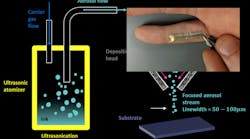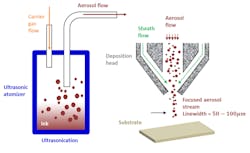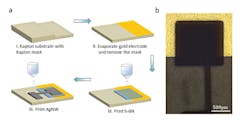Aerosol Jet Prints Skin-Friendly “Tattoos” with Active Electronics
This article appeared in Electronic Design and has been published here with permission.
A team at the Duke University Pratt School of Engineering has developed and evaluated a “print-in-place” technique for electronics that’s gentle enough to work on delicate surfaces including paper and human skin. Unlike other so-called “printed electronics” that require multiple layers supported by special treatment after each layer is added, this approach is much more direct. The result is suitable for patches and sensors for biomedical applications including patient-specific biosensors.
“Over the years there have been a slew of research papers promising these kinds of ‘fully printed electronics,’ but the reality is that the process actually involves taking the sample out multiple times to bake it, wash it, or spin-coat materials onto it,” said Aaron Franklin, the James L. and Elizabeth M. Vincent Associate Professor of Electrical and Computer Engineering at Duke. “Ours is the first where the reality matches the public perception.”
Along with Benjamin Wiley, professor of chemistry at Duke, and others, they developed a novel ink containing silver nanowires that can be printed onto any substrate at low temperatures with an aerosol printer (Figs. 1 and 2).
It yields a thin film that maintains its high conductivity (low ohmic resistance) without any further processing. After being printed, the ink is dry in less than two minutes and retains this performance even after undergoing a 50% bending strain more than 1,000 times. Check out this quick video of the process and some results:
However, their advance goes beyond the apparently simple but limited function of providing a highly conductive path along the skin surface, as described in the first of two papers, “Silver nanowire inks for direct-write electronic tattoo applications” along with Supplemental Files published in the Royal Society for Chemistry (RCS) journal Nanoscale. A second paper, in the American Chemical Society (ACS) publication Nano, “Flexible, Print-in-place 1D-2D Thin-film Transistors Using Aerosol Jet Printing” and Supporting Information explains how they extended the conductive-ink process to create passive devices such as capacitors (Fig. 3), and even active devices. Combining it with two other printable components led to the creation of functional transistors.
To do so, the printer first puts down a semiconducting strip of carbon nanotubes. Once it dries, and without removing the plastic or paper substrate from the printer, two silver nanowire leads that extend several centimeters from either side are printed. A non-conducting dielectric layer of a two-dimensional material, hexagonal boron nitride (h-BN), is then printed on top of the original semiconductor strip, followed by a final silver nanowire gate electrode.
The result is the creation of 1D-2D thin-film transistors (1D-2D TFTs) in a low-temperature (maximum exposure ≤80°C) full print-in-place process, meaning there’s no need for substrate removal from the printer throughout the entire process. The performance of these devices was evaluated using some of the standard parameters used for FET characterization (Fig. 4). In addition to an ON/OFF current ratio as high as 3.5 × 105, channel mobility up to 10.7 cm2/V-sec, and low gate hysteresis, these 1D-2D TFTs showed extraordinary mechanical stability under bending due to the nanoscale network structure of each layer, with minimal changes in performance after 1,000 bending test cycles at 2.1% strain.
This work was supported by the Department of Defense Congressionally Directed Medical Research Program (W81XWH-17-2-0045), the National Institutes of Health (1R21HL141028), and the National Science Foundation (ECCS-1542015).




